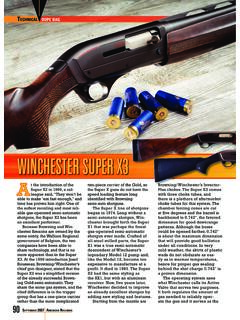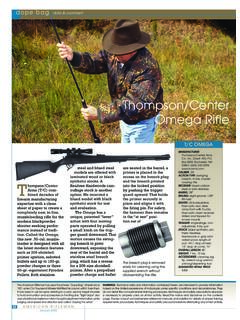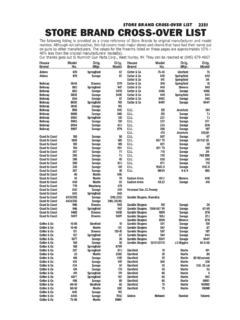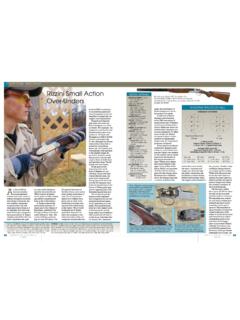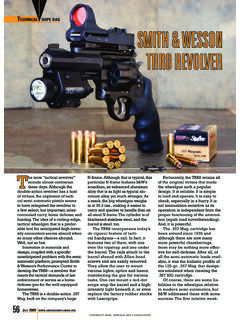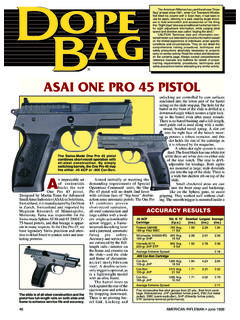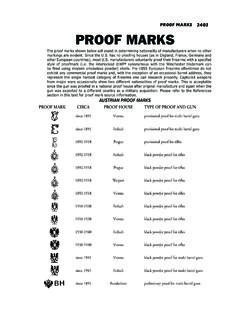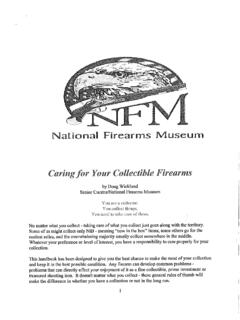Transcription of The American Rifleman has used the phrase “Dope …
1 The American Riflemanhas used the phrase DopeBag at least since 1921, when Col. Townsend Whelenfirst titled his column with it. Even then, it had been inuse for years, referring to a sack used by target shoot-ers to hold ammunition and accessories on the firingline. Sight dope also was a traditional marksman s termfor sight adjustment information, while judging windspeed and direction was called doping the wind. CAUTION: Technical data and information con-tained herein are intended to provide information basedon the limited experience of individuals under specificconditions and circumstances. They do not detail thecomprehensive training procedures, techniques andsafety precautions absolutely necessary to properlycarry on similar activity. Read the notice and disclaimeron the contents page. Always consult comprehensivereference manuals and bulletins for details of propertraining requirements, procedures, techniques andsafety precautions before attempting any similar current hot tickets forcarry guns seem to be compactautoloaders in 9x19 mm or.
2 40 S&W,there are still those who cherish the large-caliber revolver for serious personaldefense. These people put their trust inheavy, large-diameter bullets and the unpar-alleled reliability of the revolver. The epit-ome of this concept is a short-barreled,five-shot revolver in .44 Spl. chamber-ing. Smith & Wesson s new Model 696fits this description S&W 696 is a stainless-steelL-frame revolver with a 3" barrel,a fluted five-shot cylinder andrubber finger-groove are the standard S&Wadjustable unit in the rear,with a white outline notch,and a ramp front with a blazeorange plastic is identical tothat of other S&W L-frameguns and includes such tra-ditional features as the ham-mer block safety and flatmainspring. Both hammer andtrigger are casehardened. Whilethe hammer retains the checkered spur, thetrigger face is smooth, as befits a defensivegun that will be fired primarily in the dou-ble-action mode.
3 The 696 also incorporatesS&W s new cylinder latch, whose check-ered contact surface is angled forward forbetter finger purchase and easier, fastercylinder diameter on the 696 is ",giving a minimum wall thickness of .05"outside each chamber thin, but (in Smith& Wesson s testing) sufficient to contain Spl s. low-average chamber pressure of15,500 (measured by the piezoelectrictransducer method). The cylinder notchesare located between the chambers, wherethere is considerably more metal black rubber stocks terminate in around butt, and feature panels with impressedcheckering. Further contributing to a securehold are three grooves in the front of thestocks for the fingers of the shooting fired our sample Model 696 for accu-racy at 25 yards with the results in theaccompanying table, and then function-fired the gun with Black Hills, Cor-Bon andTriton loads. Since this revolver will be uti-lized primarily as a defensive arm, we alsodid considerable shooting at the more prac-tical range of seven yds.
4 At both the officialNRA B-27 silhouette target as well as theNRA Action Pistol Bianchi of this revolver wasgenerally good. It was certainlymore than adequate for its primaryintended purpose. We noted little leadingof the bore after the revolver had digestedseveral cylinderfuls of 210-gr. lead BlackHills gun s size and weight were both aboon and a bane. The 35-oz. S&W 696 mit-S&W MODEL 696 .44 SPL. REVOLVERMANUFACTURER:Smith & Wesson,Dept. AR, 2100 Roosevelt Ave.,Springfield, MA 01104 MECHANISM TYPE:double-actionrevolverCALIBER:.44 LENGTH:8"BARREL LENGTH:3"WEIGHT:35 :11 2"HEIGHT:53 4"CYLINDER CAPACITY:fiveRIFLING:five-groove, RH twistTRIGGER:double-action, 10 lbs. pull;single-action, 4 lbs. pullSIGHTS:click-adjustable white-outlinerear, orange ramp frontACCESSORIES:Master trigger lockPRICE:$509S&W MODEL 696 With its size, weight and five-round .44 Spl. capacity, the S&W 696 revolverbucks the trend of smaller, lighter high-er-capacity pistols for discrete Model 696 has S&W s new-style cylin-der latch, that has checkered contact sur-face and is angled forward for better fingerpurchase and easier, faster cylinder Rifleman January 1998 American Rifleman January 199849igated much of the recoil from even thestoutest load fired.
5 With most ammunitiontypes the 696 s recoil was no worse than148-gr. target wadcutters fired from a .38 Spl. J-frame revolver. The down side is thata large, heavy gun is generally hard to con-ceal. Even with the round butt and short bar-rel, there is just no getting around the factthat this is an L-frame 10 lbs., the gun s double-action trig-ger pull was a little heavier than expected,with some stacking toward the end oftrigger travel. Additionally, when thetrigger was pulled very slowly, therewas an audible click just prior to letoff,after which the force required to com-plete the pull suddenly increased. Thiscreated the unusual circumstance inwhich our 696 s double-action pullweight was worse when the trigger waspulled slowly than when it was pressedmore quickly and test firers listed a few areas inwhich the 696 might be small-handed staffers whotest-fired the 696 gave the gun mixedreviews: they liked its low recoil andround-butt rubber stocks but found itstrigger reach and pull weight a bitdaunting.
6 Those samestocks, however, should bereplaced by those who carrythe gun under a loose shirtor jacket, as rubber tends tostick to clothing and createa tell-tale pattern of wrin-kles and bulges. Some alsofelt that the stainless steelfront sight blade picked uptoo much light, and wouldhave been more functionalwith a matte black chambers forfaster reloading were also onthe wish list as was a morethorough job of removingsharp edges. Such changes, however, areminor and could easily be performed by anycompetent pistolsmith. As with all newS&Ws, a trigger lock is included, at an addi-tional cost, of its size, its 35-oz. weight and itsfive-round .44 Spl. capacity, the S&W 696bucks the trend toward smaller, lighter,higher-capacity semi-automatic , the 696 offers excellent relia-bility, good accuracy, low recoil and a mod-erately powerful chambering in a size thatcan be carried discreetly by many is a formidable combination of featuresthat prospective handgun buyers might dowell to @15' Smallest Largest AverageCartridge( )(ins.)
7 (ins.)(ins.)Black Hills598 FPL12 SdCor-Bon 44S165949 JHP16 SdTriton TR44 SHVB 884 BHP29 SdAverage Extreme consecutive five-shot groups from 25 yds., fired fromRansom Rest. Abbreviations: Sd (standard deviation), FPL(flat point lead), JHP (jacketed hollow-point), BHP (brass hol-low-point).ACCURACY RESULTSC ylinder diameter on the Model 696 ", giving a minimum wall thickness " outside each chamber thin, but suf-ficient to contain the low-pressure .44 , the lockwork is identical to thatof other S&W L-frame revolvers, includingsuch traditional features as S&W s ham-mer-block safety and a flat England is well knownfor its rich gunmaking tradition,one would hardly expect a newfirearms manufacturing company to start upin Brooklyn, New York. The HenryRepeating Arms Co. (HRAC) has done justthat. The new manufacturer offers gunsbilled as Made in America and priced right. The rifle the NRA Technical Staffreceived for testing is the Henry LeverAction.
8 22 the first of two rifles beingintroduced by HRAC. The other gun is anupdated copy of the semi-automatic AR-7 Survival sample, with its straight walnutstock, blued 181 2" steel barrel, two barrelbands and round steel finger lever resemblesthe well known Winchester Model 9422. Themajor external difference between those tworifles are the two bolts on either side of theHenry s receiver, which are absent on theHENRY LEVER ACTION .22 RIFLEThe new Henry Repeating Arms Co. offers rifles Made in Americaand priced right. The rifle we tested is the Henry Lever Action .22 the first of two models being made by HRAC at the time of this A closer look reveals other dif-ferences, including the use by HRAC of azinc/aluminum alloy called Zamak with abaked-on black enamel finish for what onecould mistake as the receiver. Another dif-ference is the absence of a take-down fea-ture and stock checkering on the comparison does not mean that theHenry rifle, at nearly half the price of the9422, is a poor man s Winchester.
9 Thoughthe two rifles have an outward resemblance,they are entirely action of the Henry Lever Action .22rifle is completely unlike what most are usedto in this type of gun. What appears to be aconventional receiver is in fact a cover thathelps guide the bolt: the steel receiver prop-er is inside this cover and contains all inter-nal parts, sans the bolt, which are pinned orscrewed into , the Henry s hammer is pow-ered by a single strand, coil mainspring act-ing on a hammer strut. For a carrier, theHenry employs a stamped steel piece that islifted by a spring-loaded plunger in the bot-tom of the receiver. When the action isclosed, an extension on the lever presses thecarrier down, allowing the next cartridge inthe tubular magazine to feed from the forceof the follower spring. An upward extensionon the front of the carrier actsas the other functions areperformed by the finger extension on the leverengages a slot milled into theleft side of the bolt to move itback and forth as the lever islowered and raised.
10 Ad-ditionally, as the lever is low-ered, it cams the spring-loaded locking block downfrom its notch in the the lever is closed, the locking blockis pressed up by a coil spring into the boltto lock the blued steel barrel has multiple-groove rifling similar to Marlin s Micro-Groove. Both barrel bands, as well as thebuttplate are black of the conventional tubularsteel magazine located under the Henry sbarrel is 15 Long Rifle, 17 Long and 21 Short cartridges. Loading is through a car-tridge-shaped cut-out in the underside of features are limited to a tradi-tional half-cock hammer position that isengaged by first bringing the hammer to fullcock. Then, with the gun pointed in a safedirection, pull the trigger and carefullylower the hammer tohalf-cock. The manualwarns that the half-cocksafety ..will not nec-essarily prevent theaccidental discharge ofthis firearm as a resultof jarring or abuse.

